Excerpts
from "Blood and Tears"
Book by Qutubuddin Aziz |
|
read book reviews |
buy books
|
|
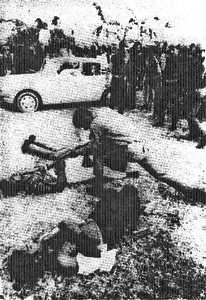 |
Looking at
the tragic events of March 1971 in retrospect, I must confess that
even I, although my press service commanded a sizeable network of
district correspondents in the interior of East Pakistan, was not
fully aware of the scale, ferocity and dimension of the province-wide
massacre of the non-Banglis.
I must stress, with all the force and sincerity at my command, that
this bock is not intended to be a racist indictment of the Bengalis
as a nation. In writing and publishing this book, I am not motivated
by any revanchist obsession or a wish to condemn my erstwhile Bengali
compatriots as a nation. Just as it is stupid to condemn the great
German people for the sins of the Nazis, it would be foolish to
blame the Bengali people as a whole for the dark deeds of the Awami
League militants and their accomplices.
I have incorporated in this book the acts of heroism and courage
of those brave and patriotic Bengalis who sheltered and protected,
at great peril to themselves, their terror-stricken non-Bengali
friends and neighbours. On the basis of the heaps of eye-witness
accounts, which I have carefully read, sifted and analysed, I do
make bold to say that the vast majority of Bengalis disapproved
of and was not a party to the barbaric atrocities inflicted on the
hapless non-Bengalis by the Awami League's terror machine and the
Frankensteins and vampires it unloosed. This silent majority, it
seemed, was awed, immobilised and neutralised by the terrifying
power, weapons and ruthlessness of a misguided minority hell-bent
on accomplishing the secession of East Pakistan.
The sheaves of eye-witness accounts, documented in this book, prove
beyond the shadow of a doubt that the massacre of West Pakistanis,
Biharis and other non-Bengalis in East Pakistan had begun long before
the Pakistan Army took punitive action against the rebels late in
the night of March 25, 1971. It is also crystal clear that the Awami
League's terror machine was the initiator and executor of the genocide
against the non-Bengalis which exterminated at least half a million
of them in less than two months of horror and trauma. Many witnesses
have opined that the federal Government acted a bit too late against
the insurgents. The initial success of the federal military action
is proved by the fact that in barely 30 days, the Pakistan Army,
with a combat strength of 38,717 officers and men in East Pakistan,
had squelched the Awami League's March-April, 1971, rebellion all
over the province.
|
Typical
of the open-air, human abattoirs operated by the Awami League-led
rebels in East Pakistan in 1971 is this photograph of multiple-executions
done by a Mukti-Bahini killer squad in Dacca Race Course. The pro-Pakistan
Bengali and non-Bengali victims were tortured before being slain |
The hundreds of eye-witnesses
from towns and cities of East Pakistan, whose testimonies are documented
in this book, are unanimous in reporting that the slaughter of West
Pakistanis, Biharis, and other non-Bangalis and of some pro-Pakistan
Bengalis had begun in the early days of the murderous month of March
1971.
Looking at the tragic events of March 1971 in retrospect, I must confess
that even I, although my press service commanded a sizeable network
of district correspondents in the interior of East Pakistan, was not
fully aware of the scale, ferocity and dimension of the province-wide
massacre of the non-Banglis. |
|
| |
I must stress,
with all the force and sincerity at my command, that this bock is
not intended to be a racist indictment of the Bengalis as a nation.
In writing and publishing this book, I am not motivated by any revanchist
obsession or a wish to condemn my erstwhile Bengali compatriots as
a nation. Just as it is stupid to condemn the great German people
for the sins of the Nazis, it would be foolish to blame the Bengali
people as a whole for the dark deeds of the Awami League militants
and their accomplices.
I have incorporated in this book the acts of heroism and courage of
those brave and patriotic Bengalis who sheltered and protected, at
great peril to themselves, their terror-stricken non-Bengali friends
and neighbours. On the basis of the heaps of eye-witness accounts,
which I have carefully read, sifted and analysed, I do make bold to
say that the vast majority of Bengalis disapproved of and was not
a party to the barbaric atrocities inflicted on the hapless non-Bengalis
by the Awami League's terror machine and the Frankensteins and vampires
it unloosed. This silent majority, it seemed, was awed, immobilised
and neutralised by the terrifying power, weapons and ruthlessness
of a misguided minority hell-bent on accomplishing the secession of
East Pakistan.
The 170 eye-witnesses, whose testimonies or interviews are contained
in this book in abridged form have been chosen from a universe of
more than 5,000 repatriated non-Bengali families. I had identified,
after some considerable research, 55 towns and cities in East Pakistan
where the abridgement of the non-Bengali population in March and early
April 1971 was conspicuously heavy. The collection and compilation
of these eye-witness accounts was started in January 1974 and completed
in twelve weeks. A team of four reporters, commissioned for interviewing
the witnesses from all these 55 towns and cities of East Pakistan,
worked with intense devotion to secure their testimony. Many of the
interviews were prolonged because the Witnesses broke down in a flurry
of sobs and tears as they related the agonising stories of their wrecked
lives. I had issued in February 1974 an appeal in the newspapers for
such eye-witness accounts, and I am grateful to the many hundreds
of witnesses who promptly responded to my call. |
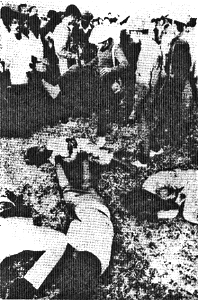 |
A
scene of Mukti Bahini mass murder of Biharis in Dacca on December
18, 1971. A rebel soldier lifts his boot to strike a bleeding bayoneted
boy who showed signs of life. Dead bodies of other slain non-Bengalis
lie in the foreground. |
“I am the lone survivor
of a group of ten Pathans who were employed as Security Guards by
the Delta Construction Company in the Mohakhali locality in Dacca;
all the others were slaughtered by the Bengali rebels in the night
of March 25, 1971”, said 40-year-old Bacha Khan.
“I
heard the screams of an Urdu-speaking girl who was being ravished
by her Bengali captors but I was so scared that I did not have the
courage to emerge from hiding” said a 24-year-old Zahid Abdi,
who was employed in a trading firm in Dacca. He escaped the slaughter
of the non-Bengalis in the crowded New Market locality of Dacca on
March 23, 1971 and was sheltered by a God-fearing Bengali in his shop.
The killers raped their non-Bengali teenage victim at the back of
the shop and later on slayed her. |
|
|
| |
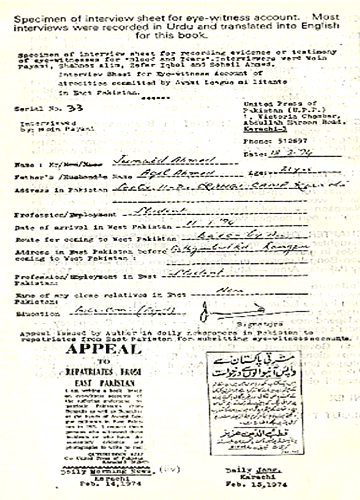 |
“My
only daughter has been insane since she was forced by her savage
tormentors to watch the brutal murder of her husband”, said
Mukhtar Ahmed Khan, 43, while giving an account of his suffering
during the Ides of March 1971 in Dacca….“In the third
week of March 1971, a gang of armed Bengali rebels raided house
of my son-in-law and overpowered him. He was a courageous Youngman
and he resisted the attackers. My daughter also resisted the attackers
but they were far too many and they were well armed. They tied up
my son-in-law and my daughter with ropes and they forced her to
watch as they slit the throat of her husband and ripped his stomach
open in the style of butchers. She fainted and lost consciousness.
Since that dreadful day she has been mentally ill."
Shamim Akhtar, 28, whose husband was employed as a clerk in the
Railway office in Dacca, lived in a small house in the Mirpur locality
there.
She described her tragedy in these words:
“On December 17, 1971, the Mukti Bahini cut off the water
supply to our homes. We used to get water from a nearby pond; it
was polluted and had a bad odour. I was nine months pregnant. On
December 23, 1971, I gave birth to a baby girl. No midwife was available
and my husband helped me at child birth. Late at night, a gang of
armed Bengalis raided our house, grabbed my husband and trucked
him away. I begged them in the name of God to spare him as I could
not even walk and my children were too small. The killers were heartless
and I learnt that they murdered my husband. After five
days, they returned and ordered me and my children to vacate the
house as they claimed that it was now their property.”
Zaibunnissa Haq, 30, whose journalist husband,
Izhar-ul-Haque, worked as a columnist in the Daily Watan in Dacca,
gave this account of her travail in 1971: |
A
copy of the ads and the forms used for soliciting testimony from
the victims. |
“….On
December 21, a posse of Mukti Bahini soldiers and some thugs rode
into our locality with blazing guns and ordered us to leave our house
as, according to them, no Bihari could own a house in Bangladesh.
For two days, we lived on bare earth in an open space and we had nothing
to eat. Subsequently, we were taken to a Relief Camp by the Red Cross.”
In Pubail and Tangibari, the Awami League militants and their rebel
confederates murdered dozens of affluent Biharis. Shops owned by the
Biharis were favourite target of attack. |
|
| |
“Four armed thugs dragged two captive non-Bengali
teenage girls into an empty bus and violated their chastity before
gunning them to death”, said Gulzar Hussain, 38, who witnessed
the massacre of 22 non-Bengali men, women and children on March
21, 1971, close to a bus stand in Narayangang. Repatriated to
Karachi in November 1973, Gulzar Hussain reported: "….On
March 21, our Dacca-bound bus was stopped on the way, soon after
it left the heart of the city. I was seated in the front portion
of the bus and I saw that the killer gang had guns, scythes and
daggers. The gunmen raised 'Joi Bangla' and anti-Pakistan slogans.
The bus driver obeyed their signal to stop and the thugs motioned
to the passengers to get down. A jingo barked out the order that
Bengalis and non-Bengalis should fall into separate lines. As
I spoke Bengali with a perfect Dacca accent and could easily pass
for a Bengali, I joined the Bengali group of passengers. The killer
gang asked us to utter a few sentences in Bengali which we did.
I passed the test and our tormentors instructed the Bengalis to
scatter. The thugs then gunned all the male non-Bengalis. It was
a horrible scene. Four of the gunmen took for their loot two young
non-Bengali women and raped them inside the empty bus. After they
had ravished the girls, the killers shot them and half a dozen
other women and children.”
She described her tragedy in these words:
|
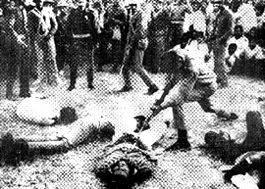
|
As
the victim did not die in a single bayonet strike, another Mukti-Bahini
killer plunged his bayonet in to the writhing Bihari’s chest.
Dead bodies of Bihari and Bengali victims lie strewn over the execution
ground as Mukti-Bahini killers and their accomplices watch the butchery
with sadist pleasure. |
“On December 17,
1971, the Mukti Bahini cut off the water supply to our homes. We
used to get water from a nearby pond; it was polluted and had a
bad odour. I was nine months pregnant. On December 23, 1971, I gave
birth to a baby girl. No midwife was available and my husband helped
me at child birth. Late at night, a gang of armed Bengalis raided
our house, grabbed my husband and trucked him away. I begged them
in the name of God to spare him as I could not even walk and my
children were too small. The killers were heartless and I learnt
that they murdered my husband. After five days,
they returned and ordered me and my children to vacate the house
as they claimed that it was now their property.”
|
|
|
| |
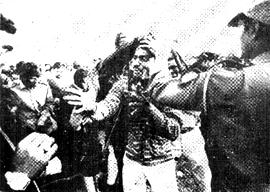 |
Zaibunnissa
Haq, 30, whose journalist husband, Izhar-ul-Haque, worked as a columnist
in the Daily Watan in Dacca, gave this account of her travail in
1971: “….On December 21, a posse of Mukti Bahini soldiers
and some thugs rode into our locality with blazing guns and ordered
us to leave our house as, according to them, no Bihari could own
a house in Bangladesh. For two days, we lived on bare earth in an
open space and we had nothing to eat. Subsequently, we were taken
to a Relief Camp by the Red Cross.”
Nasima Khatoon, 25, lived in a rented house in the Pancho Boti locality
in Narayanganj. Her husband, Mohammad Qamrul Hasan, was employed
in a Vegetable Oil manufacturing factory. Repatriated to Karachi
in January 1974, along with her 4-year-old orphaned daughter, from
a Red Cross Camp in Dacca, Nasima gave this hair-raising account
of her travail in 1971: |
A
Bihari victim grabbed by Mukti-Bahini killers, begging for mercy. |
|
| |
“At gun point, our captors
made us leave our house and marched us to an open square where
more than 500 non –Bengali old men, women and children were
detained. Some 50 Bengali gunmen led us through swampy ground
towards a deserted school building. On the way, the 3-year-old
child of a hapless captive woman died in her arms. She asked her
captors to allow her to dig a small grave and bury the child.
The tough man in the lead snorted a sharp ‘NO’, snatched
the body of the dead child from her wailing mother and tossed
it into the river”
The Awami League's rebellion of March 1971 took the heaviest toll
of non-Bengali lives in the populous port city of Chittagong.
Although the Government of Pakistan's White Paper of August 1971
on the East Pakistan crisis estimated the non-Bengali death toll
in Chittagong and its neighbouring townships during the Awami
League's insurrection to be a little under 15,000, the testimony
of hundreds of eye-witnesses interviewed for this book gives the
impression that more than 50,000 non-Bengalis perished in the
March 1971 carnage. Thousands of dead bodies were flung into the
Karnaphuli river and the Bay of Bengal.
Savage killings also took place in the Halishahar,
Kalurghat and Pahartali localities where the Bengali rebel soldiers
poured petrol and kerosine oil around entire blocks, igniting
them with flame-throwers and petrol-soaked jute balls, then mowed
down the non-Bengali innocents trying to escape the cordons of
fire. In the wanton slaughter in the last week of March and early
April, 1971, some 40,000 non-Bengalis perished in Chittagong and
its neighbourhood. The exact death toll, which could possibly
be much more will never be known because of the practice of burning
dead bodies or dumping them in the river and the sea.
|
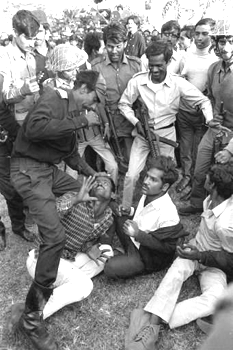
|
The
uniformed killer puffing the cigarette to singe the eyes of the
terrified prey. Eye gouging and burning the skin of victims was
a favourite torture method of the rebels. |
|
| |
|
| |
|


